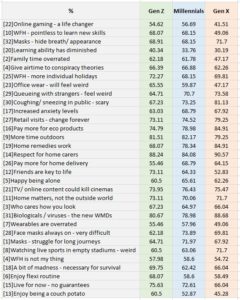Background: We are in the midst of a unprecedented outbreak of mass proportions. We in India have seen have seen a series of all possible forms of lockdowns and un–lockdowns, the problem still seems to be looming large upon us. A new normal has gotten recalibrated and is here to stay.
So, what’s on Indians’ minds? Have perceptions, attitudes and beliefs changed with COVID?…how and to what extent?…amongst whom? Let’s figure this out.
Data source: Kalos 2020, a worldwide survey across 15 nations, with over 7,000 respondents by Kaleidosense in partnership with JSM (Juxt Smartmandate) Analytics and Toluna. This is India specific data.
Approach: Ratings on various attitudes were considered for analysis. The 3 categories of age groups have been defined as, Gen Z (aged between 8-23 years), Millenial (aged between 24-39 years) and GenX (aged between 40-55 years).
Data was converted to a contingency table of association, as below and used as input for further Analysis.

We have applied a Technique called Correspondence Analysis (CA) which is a multivariate statistical technique which essentially reduces the dimension of the data without information loss. In other words, CA is used to graphically visualize row points and column points in a low dimensional space. It identifies the main relationships between the rows and columns on a table and plots them on a two-dimensional map. It handles a categorical Independent variable with a categorical Dependent variable
CA shows relative relationships between & within two groups of variables. Relative distances & angles between and within variables & from origin, are key to drawing insights

Insight
With the above correspondence analysis map, we arrived at more apparent conclusions and it allowed us to quickly identify the associations
GEX X (Aged 40-55) is now anxious about queuing with strangers and scared about sneezing in public; is beginning to respect and value the role of those who stay at home and do house work; does not mind paying more eco-friendly products and feels that Biologicals(virus) are the new WMDs (weapons of mass destruction) and the world does not need weapons anymore!
Whereas Millennial (age 24-39) feel that their anxiety levels are up, dreading the thought of wearing masks all the time in future, and suddenly see that wearables are not so useful as thought out to be. This generation is in fact is very troubled with ‘wfh’(working from home) and feels that family time is overrated J ; are of the opinion that Cinema will lose relevance with so much content being available online.
Whereas Young kids GENZ (Aged 8-23) has a ‘carpe diem’ philosophy and agrees that one has to live for now (because you never know what tomorrow has in store for you); and of course, ‘friends are the key to life’;



